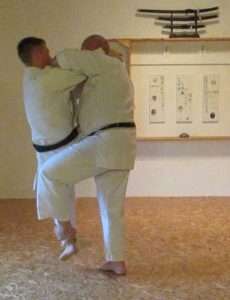Tegumi; An ancient martial art.
Tegumi is an ancient martial art that originated in the old Ryukyu kingdom. Many masters believe it to be the original form of fighting in Okinawa and a part of the art that eventually became known as Te or Todi. The term “Tegumi” itself translates to “hand wrestling” or “grappling.”

Tegumi was historically practiced as a form of self-defense among the indigenous people of Okinawa. It served as a means to settle disputes without causing severe injury or death. Tegumi techniques were developed based on the principles of balance, leverage, and using an opponent’s energy against them.
Tegumi practitioners engaged in standing grappling, throws, joint locks, and limb manipulations. The art emphasized constant movement, circular motions, and footwork to control and evade opponents. Sensitivity, timing, and adaptability were crucial in reading an opponent’s movements and intentions.
The goal of tegumi was to unbalance opponents and bring them to the ground. Once on the ground, various techniques such as joint locks and submissions were employed to control or immobilize the opponent. Tegumi did not have a point-based system or specific rules for competition; its focus was on practical self-defense and personal growth.
Notable Okinawan martial arts masters such as Motobu and Funakoshi, are known to have trained in tegumi in their childhood.
Gichin Funakoshi recalls (From the book: My way of life):
Tegumi is, of course, a far simpler and more primitive sport than karate. In fact, there are few rules except for certain prohibitions: the use of fists, for example, to strike an opponent, or the use of the feet and the legs to kick him. Nor are opponents permitted to grab each other’s hair or pinch one another. Prohibited also are the sword hand and the elbow blow used in karate.
The bout begins, as Sumo does, with the two opponents pushing against each other. Then, as it proceeds, grappling and throwing techniques are used.
The referees were usually boys who acted also as seconds to the opponents, their principal role being to ensure that neither participant was seriously injured or knocked unconscious. To stop the fight, all that any boy who felt he had had enough needed to do was to pat his opponent’s body. Some boys, however, were so dauntless that they would go on fighting until they were knocked out. In such cases, it would be the duty of the referee to try to stop the bout before that happened.
Like every other Okinawan boy, I spent many happy hours engaging in or watching tegumi bouts, but it was after I had taken up karate seriously that I came to realize that tegumi offers a unique opportunity for training, in that it need not be limited to two participants. One (usually, of course, an older and stronger boy) may take on two or three opponents or as many as he feels up to.
Shōshin Nagamine recalls (From the book: Tales of Okinawa’s great masters):
Actually, there are no accurate historical documents surrounding the origins of grappling in Okinawa. It is believed that grappling ascended from primitive man’s instinctive means of self-preservation.
In the history of civil fighting traditions here in Okinawa, we refer to such grappling concepts as tegumi. There is every reason to believe that tegumi, after being enhanced by techniques of striking and kicking, also served as the progenitor of “te.”
While the tradition was called tegumi in Naha, it was known as Mutou in both Tomari and Shuri where it remained a popular cultural recreation until the Taisho period. In its early recreational form, tegumi was quite a rough and tumble practice. Notwithstanding, it is believed that the tradition was not completely unlike present day amateur wrestling where the victor is the one who conclusively defeats his opponent by twisting his joints, sealing his breath, or holding him down so that he can no longer move.
Since those early times, tegumi has been refined and a firm set of rules and regulations has been developed. It unfolded as a popular cultural tradition and has been handed down to this day. According to island folklore, Okinawan sumo ascended from tegumi.
In the old days, any open space, field, or mountainside where people could freely gather and watch in their own comfort was sufficient. During that time there were no special rules or regulations about the size or configuration of the ring. The only condition was that the grappling surface had to be free of small stones or anything else that might be of danger to the grapplers. Usually, such bouts took place on a lawn, or surface covered by sand or sawdust to ensure safety for the athletes.
Final comment
Historical documentation of Tegumi is limited, and the art has evolved and adapted over time. Exploring the world of Tegumi provides insights into the roots of Okinawan martial arts and the development of Karate. It enhances one’s overall martial arts skill set and practical applications of grappling techniques.
Thanks for reading.
Gert

sharp! thank you so much
You’re welcome! 😊